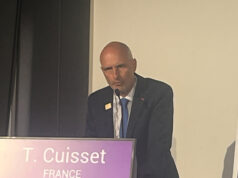
A comparison of newer generation self-expanding valves (SEV) and balloon-expandable valves (BEV) in high-risk patients with aortic stenosis undergoing transfemoral transcatheter aortic valve implantation (TAVI) has found that they are equivalent for the primary valve-related efficacy endpoint. The authors of the study say it supports the safe application of the newer generation valves in the majority of patients, with some specific preferences based on individual valve anatomy.
The 30-day results for SOLVE-TAVI (Comparison of second-generation self-expandable versus balloon expandable valves and general versus local anaesthesia in transcatheter aortic valve implantation) were published in the European Heart Journal by Holger Thiele (Heart Center Leipzig at University of Leipzig and Leipzig Heart Institute, Leipzig, Germany) et al.
The multicentre, open-label, two by two factorial randomised trial of 447 patients with aortic stenosis undergoing transfemoral TAVI was conducted at seven German sites, and compared an SEV (Evolut R, Medtronic) with a BEV (Sapien 3, Edwards Lifesciences).
Patients with symptomatic aortic stenosis, age ≥75 years and at high risk for conventional surgical aortic valve replacement (SAVR) were eligible for enrolment. Apart from the valve type, all other interventions did not differ between groups. Clinical follow-up was performed at discharge and 30 days, and by protocol will also be continued at six, 12, 24, and 60 months. The primary endpoint for the valve comparison was a composite of all-cause mortality, stroke, moderate or severe paravalvular leak (PVL), and permanent pacemaker implantation at 30-day follow-up. Secondary endpoints of the valve analysis included device success, early safety, clinical efficacy, time-related safety, and cardiovascular mortality according to the Valve Academic Research Consortium (VARC)-2 criteria. In addition, the cardiovascular mortality at 30 days, individual components of the primary endpoint, mean length of primary hospital stay, quality of life according to the EuroQuol-5 questionnaire (EQ-5D), device time, and total procedural time were assessed. The study was powered for equivalence of the composite primary endpoint.
Between April 2016 and April 2018, 447 patients were randomised—225 to SEV and 222 to BEV implantation. Of these, 438 patients underwent the TAVI procedure and were eligible for further analysis. Patients were at high to intermediate risk, with a mean age of >80 years and a median logistic EuroSCORE I of 14.8% [interquartile range (IQR) 8.7–23.8%] and STS score of 4.7% (IQR 3.0–9.8%). Baseline characteristics were well balanced between the two valve treatment groups. Cross-over from SEV to BEV occurred in two patients (0.9%), to other valves in two patients, and in the opposite direction in one patient. In all, 218 patients in the SEV and 215 patients in the BEV group were included in the primary endpoint analysis.
Thiele and colleagues found that, at 30 days, the rate of the composite primary endpoint of all-cause mortality, stroke, moderate or severe PVL, and permanent pacemaker implantation was equivalent between SEV and BEV (28.4% vs. 25.9%, rate difference -2.51, 90% confidence interval [CI] -9.65–4.53, Pequivalence =0.04). Only minor variation in the rate difference was observed in the per-protocol population (27% for SEV vs. 25.5% for BEV, rate difference 1.48, 90% CI -8.61–5.65, Pequivalence=0.03). Prespecified subgroup analyses revealed consistent results across all subgroups.
Individual components of the primary endpoint were: all-cause mortality 3.2% for SEV versus 2.3% for BEV (rate difference -0.94, 90% CI -4.79–2.91, Pequivalence <0.001); stroke 0.5% for SEV versus 4.7% for BEV (rate difference 4.2, 90% CI 0.11–8.28, Pequivalence=0.003); moderate/severe paravalvular leak 3.4% for SEV versus 1.5% for BEV (rate difference -1.92, 90% CI -5.88–2.05, Pequivalence =0.0001); permanent pacemaker implantation 23% for SEV versus 19.2% for BEV (rate difference -3.85, 90% CI -10.41–2.72, Pequivalence =0.06).
The authors note that permanent pacemaker implantation rates were “relatively high” and say they are “in the upper range of previously reported trials and registries”. They surmise: “There were no differences in the indication for pacemaker implantation in both groups, and it may be speculated that in some centres a more liberal indication has been applied for patients with long AV-block I and new left bundle branch block. Implantation depth and anatomical factors with more severe calcification may also have contributed to the relatively high pacemaker rate. Furthermore, implantation depth, need for additional balloon valvuloplasty, balloon and prosthesis size are well-known factors for pacemaker implantation which may be reduced with a further learning curve.”
Device time and total procedural time were similar between both treatment groups. However, fluoroscopy time and overall doses of contrast agent were higher in the SEV group in comparison to the BEV group. There were no differences in major bleeding complications, acute kidney injury or the need and doses of vasopressors and inotropes between groups.
The researchers also found that valve-related outcomes according to VARC-2 criteria for device success and early safety fulfilled the criteria of equivalence, but clinical efficacy and time-related safety did not show equivalence. Time-related safety was significantly better for the SEV, mainly driven by a higher rate of patients with a gradient ≥20mmHg in the BEV group at 30-day follow-up. In addition, overall quality of life according to the EQ-5D questionnaire was not statistically different between the two treatment groups.
Writing in the European Heart Journal, Thiele et al say: “The present randomised study significantly adds to the body of evidence of newer generation SEV versus BEV by showing equivalence for a combined clinical endpoint consisting of four clinically relevant components.”
They conclude: “Among high-risk patients with aortic stenosis, new generation SEV in comparison to BEV are equivalent with respect to the composite of all-cause mortality, stroke, permanent pacemaker implantation, and PVL. These findings support the safe application of these newer generation percutaneous valves which may be chosen on a general basis in the majority of patients with some specific preferences based on individual valve anatomy.”













